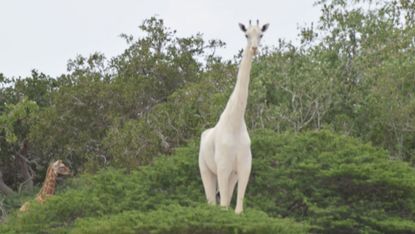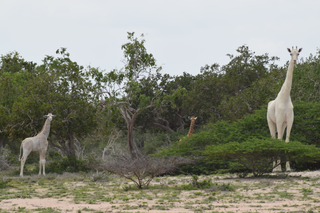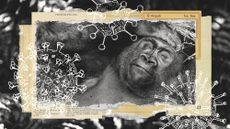Ultra-rare white giraffes spotted in Kenya
The mother and calf are only the third recorded example of leucistic giraffes in history

A pair of giraffes with a rare genetic mutation that turns their skin white has been captured on camera for only the third time in history.
The mother and calf were first spotted by locals in the Ishaqbini conservation area, northern Kenya, in June. Last month, rangers from the Hirola Conservation Program, which manages the protected area, came face-to-face with the creatures and captured their close encounter on video.
“They were so close and extremely calm and seemed not disturbed by our presence,” the HCP wrote in a blog. “The mother kept pacing back and forth a few yards in front of us while signalling the baby giraffe to hide behind the bushes.”
Subscribe to The Week
Escape your echo chamber. Get the facts behind the news, plus analysis from multiple perspectives.

Sign up for The Week's Free Newsletters
From our morning news briefing to a weekly Good News Newsletter, get the best of The Week delivered directly to your inbox.
From our morning news briefing to a weekly Good News Newsletter, get the best of The Week delivered directly to your inbox.

Their unusual appearance is due to a condition called leucism, rather than the better-known albinism. While albinism means a total loss of one form of pigmentation, leucism is a partial loss of all pigmentation.
This is only the third known instance of the rare genetic mutation in the species.
The first documented sighting occurred in January 2016, in a national park in Tanzania. Locals named the white calf Omo after a popular local brand of detergent, National Geographic reports.
Two months later, a second white giraffe was seen in the same Kenyan conservation park.
The mother and calf are an extremely rare example of an increasingly rare breed. The reticulated giraffe, also called the Somali giraffe, is considered a “vulnerable” subspecies.
“As recently as the turn of the millennium, some 36,000 remained,” according to the Reticulated Giraffe Project. That number is now thought to be around 8,500.
A ranger identified as Bashir told the HCP that the white giraffes appeared to be a new phenomenon.
“I remember when I was a kid, we never saw them. It must be very recent and we are not sure what is causing it,” he said.
Create an account with the same email registered to your subscription to unlock access.
Sign up for Today's Best Articles in your inbox
A free daily email with the biggest news stories of the day – and the best features from TheWeek.com
-
 'A speaker courageous enough to stand up to the extremists in his own party'
'A speaker courageous enough to stand up to the extremists in his own party'Instant Opinion Opinion, comment and editorials of the day
By Harold Maass, The Week US Published
-
 How could the Supreme Court's Fischer v. US case impact the other Jan 6. trials including Trump's?
How could the Supreme Court's Fischer v. US case impact the other Jan 6. trials including Trump's?Today's Big Question A former Pennsylvania cop might hold the key to a major upheaval in how the courts treat the Capitol riot — and its alleged instigator
By Rafi Schwartz, The Week US Published
-
 Today's political cartoons - April 18, 2024
Today's political cartoons - April 18, 2024Cartoons Thursday's cartoons - impeachment Peanuts, record-breaking temperatures, and more
By The Week US Published
-
 How the EU undermines its climate goals with animal farming subsidies
How the EU undermines its climate goals with animal farming subsidiesUnder the radar Bloc's agricultural policy incentivises carbon-intensive animal farming over growing crops, despite aims to be carbon-neutral
By Harriet Marsden, The Week UK Published
-
 Chimpanzees are dying of human diseases
Chimpanzees are dying of human diseasesUnder the radar Great apes are vulnerable to human pathogens thanks to genetic similarity, increased contact and no immunity
By Harriet Marsden, The Week UK Published
-
 Can the world really wean itself off coal?
Can the world really wean itself off coal?Today's Big Question 'Record' global consumption is set to fall soon but growing demand in China and India could increase tensions
By Harriet Marsden, The Week UK Published
-
 The microplastics hurricanes blowing across North America
The microplastics hurricanes blowing across North AmericaUnder the Radar New research confirms global pervasiveness of harmful microplastic pollution
By The Week Staff Published
-
 What can Cop28 really achieve?
What can Cop28 really achieve?Today's Big Question Climate summit in UAE proves controversial as UN warns world is falling short of global warming targets
By The Week UK Published
-
 A23a: why world's biggest iceberg is on the move
A23a: why world's biggest iceberg is on the moveThe Explainer The mass of ice is four times the size of New York and 'essentially' an island
By Chas Newkey-Burden, The Week UK Published
-
 Libya floods: death toll set to rise with 10,000 reported missing
Libya floods: death toll set to rise with 10,000 reported missingMore than 6,000 people reported dead, with hundreds of bodies still washing ashore
By Arion McNicoll Published
-
 Thousands feared dead in catastrophic Libya flooding
Thousands feared dead in catastrophic Libya floodingSpeed Read A powerful Mediterranean storm pummeled Libya's northeast coast, wiping out entire neighborhoods
By Peter Weber Published